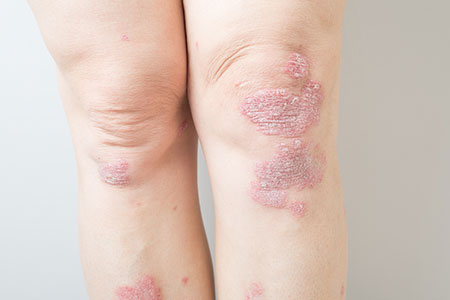
Psoriatic Arthritis
Psoriatic arthritis is a type of chronic disease characterized by inflammation of skin and joints. In this condition, a patient may develop scaly red and white patches on the skin. Psoriasis happens when the body’s immune system extensively attack to its own skin. Getting psoriatic arthritis treatment at right time can help manage the symptoms.
Risk Factors
Approximately 15% of people with psoriasis develop psoriatic arthritis. Both men and women have an equal risk of affecting with Psoriatic Arthritis. Usually, people who suffer from psoriasis may also develop psoriatic arthritis. Psoriatic arthritis is most commonly found in people between the ages of 30 to 50, but its symptoms may appear as early as childhood. Children with psoriatic arthritis may also develop Uveitis- middle layer inflammation of the eye.
Types
- Symmetric psoriatic arthritis: Affects several joints in pairs such as both elbows or both knees.
- Asymmetric psoriatic arthritis: Affects only a few joints, large or small and occur anywhere in the body. Distal interphalangeal predominant (DIP) psoriatic arthritis: Affects small joints at the ends of the toes, fingers, and the nail.
- Spondylitis: Mainly affects the spinal column to cause inflammation and stiffness between vertebrae and pelvis.
- Arthritis mutilans: Although it is rare, still most severe and destructive type of psoriatic arthritis. It badly damages and deforms the small joints in fingers and toes.
Symptoms
- General weakness/fatigue
- Tendons pain, swelling, and tenderness
- Swelling in fingers and toes
- One or more joints affected with pain, stiffness, throbbing, swelling, and tenderness
- Reduced range of motion
- Morning stiffness
- Change in Nail structure, it becomes pitted and mimics fungal infections
- Redness and pain in eyes, such as conjunctivitis
If you are experiencing the same symptoms, then do not wait and get the treatment. You can go to best doctor for psoriatic arthritis Ludhiana, Punjab for treatment.
Diagnosis
- Recognizing Disease Symptoms
- Medical and Family History
- Blood tests, imaging, and other tests
- Also, patients with psoriatic arthritis are more likely to have high BP and cholesterol, obesity, heart disease, and diabetes.
Treatment
Although there’s no permanent cure is known for psoriatic arthritis, but various newer medications can control its symptoms so well that it goes into remission.
Inflammation can be controlled with various medications which include:
- Non-steroidal anti-inflammatory drugs (NSAIDs)
- Disease-modifying anti-rheumatic drugs (DMARDs)
- Biological drugs
- Enzyme inhibitors
Exercise can help a lot to protect a joint by making the muscles around a joint stronger and flexible. Gentle.
Other alternative ways to manage psoriatic arthritis are:
- Cold and Heat Therapy
- Massage, Acupressure, and Acupuncture
- Splints and other assistive devices


